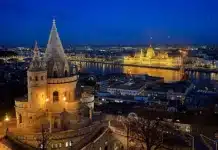Majestically crossing the Danube, Budapest’s Chain Bridge, also known as the ‘Széchenyi Lánchíd’ in Hungarian, is much more than a simple structure of steel and stone.
A witness to the tumult of history, the Chain Bridge has survived many trials, including the ravages of the Second World War. Lovingly rebuilt and restored after each adversity, it remains a cultural and historical anchor for the people of Budapest.
An ancient history and an epic construction
At the beginning of the 19th century, Budapest was booming economically and culturally, but its growth was hampered by the Danube, which divided the city into two distinct parts: Buda and Pest.
The city’s inhabitants dreamed of a link that would unite these two banks, allowing easier access and promoting the economic and social development of the region. The idea of a bridge linking Buda and Pest was born in the visionary minds of the time. However, it was not an easy undertaking. The Danube, with its rushing waters and shifting bed, represented a colossal challenge for the engineers and architects of the time.
In 1836, Count István Széchenyi, a Hungarian visionary and fervent advocate of progress, launched an initiative to build a permanent bridge across the Danube, a bold proposal that was enthusiastically welcomed by the local population.
Work began in 1839 under the direction of English engineer William Tierney Clark, a specialist in the design and construction of bridges. He designed a revolutionary structure for the time: a suspension bridge supported by iron chains. Building the bridge was an unprecedented feat of engineering. Thousands of workers worked day and night, braving the elements and overcoming countless technical challenges to achieve this architectural feat.
After years of relentless effort, the Chain Bridge was finally inaugurated on 20 November 1849, in a grandiose ceremony that marked a decisive turning point in the history of Budapest. The building quickly became the symbol of modernity and progress for the whole of Hungary.
Unfortunately, the Chain Bridge in Budapest has been destroyed and rebuilt several times over the course of its eventful history.
The first major destruction occurred during the Second World War, when in 1945, retreating German troops sabotaged the bridge to slow the advance of the Allied forces. The arches of the bridge were destroyed, leaving the bridge in a state of ruin.
After the war, Budapest, like many European cities, undertook a vast reconstruction programme. The Chain Bridge was rebuilt in the years that followed, resuming its crucial role in linking Buda and Pest in 1949.
However, the bridge was again damaged during the Hungarian uprising of 1956. This time, Soviet troops bombed the bridge, reducing it once again to rubble. Reconstruction after the uprising was a complex and laborious undertaking, but the Chain Bridge was finally restored and reopened to the public in 1958.
Elegant and majestic architecture

The architecture of Budapest’s Chain Bridge is an emblematic example of the neo-classical style that dominated architecture in the early 19th century.
The Chain Bridge is a suspension bridge, with a main structure supported by iron chains. It is around 375 metres long and has a width of around 15 metres, enough to accommodate pedestrian and vehicular traffic (only buses and taxis have been allowed on it since 2023).
As well as its elegant aesthetics, the architecture of the Chain Bridge is also remarkable for its technical ingenuity. At the time of its construction, the bridge was one of the first examples of a suspension bridge in Central and Eastern Europe, marking a significant advance in bridge engineering.
The most remarkable feature of the bridge’s architecture is its double suspension chain, which crosses the two stone arches on either side of the Danube. These chains, made of wrought iron links, not only support the structure, but also add a unique aesthetic touch to the whole building.
Although primarily functional, the Chain Bridge also features decorative elements that lend it a certain elegance. The stone arches framing the ends of the bridge are adorned with neo-classical motifs, such as garlands of laurel leaves and sculptures depicting mythological figures. The cast-iron lampposts that line the bridge also add to its architectural charm.
The lions of Budapest’s Chain Bridge are not just decorative elements, but majestic guardians who watch over travellers crossing the Danube. Positioned at each end of the bridge, these imposing sculptures add a mythical dimension to the already grandiose architecture of the building.
The lions, with their open jaws and powerful paws, seem ready to defend the bridge against any danger. Their presence inspires a sense of security and protection, strengthening the link between the two banks of the Danube and symbolising the unity and solidarity of the Hungarian people. The lions are sculpted with remarkable attention to detail, with every muscle and hair carefully sculpted to create an impression of realism and life. The lions’ expressions are equally evocative, expressing both strength and serenity, reflecting the qualities that these creatures symbolise.
The tongue of the lion

Among the many tales surrounding Budapest’s Chain Bridge, the story of the lion’s tongue is particularly amusing. Perched at one end of the bridge, this majestic lion seems to be whispering a well-kept secret through its slightly protruding tongue.
Legend has it that when sculptor János Marschalkó was commissioned to create the four lions guarding the bridge, he decided to add a touch of originality to one of the statues. Inspired by the idea of bringing his work to life, he sculpted the lion’s tongue so that it protrudes slightly from its mouth, as if it were about to utter a mysterious message.
Some say that this protruding tongue is a subtle nod to the mischievous spirit of Marschalkó, while others see it as a symbol of the lion’s silent wisdom, ready to reveal the city’s secrets to attentive travellers. Over the years, this peculiarity has become a well-known curiosity among visitors to the Chain Bridge. Tourists flock to capture shots of this singular lion, wondering what it might have to say if it could talk.
A must-see in Budapest
For visitors to Budapest, a walk along the Chain Bridge is a must. Whether to admire its spectacular architecture, to take panoramic photos of the Danube and the capital’s emblematic monuments such as the castle and Matthias Church on the Buda side, or simply to feel the vibrant atmosphere that reigns on the bridge, this walk along the bridge is not to be missed!
Finally, watch a video of Budapest’s superb Chain Bridge:
Address: Chain Bridge, Széchenyi Lánchíd, 1051 Budapest – map –
How to get to the Chain Bridge
The Chain Bridge is located right in the centre of Budapest and is easy to get to using Budapest’s public transport system:
Pest side:
The nearest metro station is Vörösmarty tér (line number 1, yellow) and by bus lines 16 and 16A.
With the superb tramway line 2, which runs along the Danube, get off at the ‘Széchenyi István tér’ stop.
On the Buda side: bus lines 16 and 16A, which cross the bridge.


















